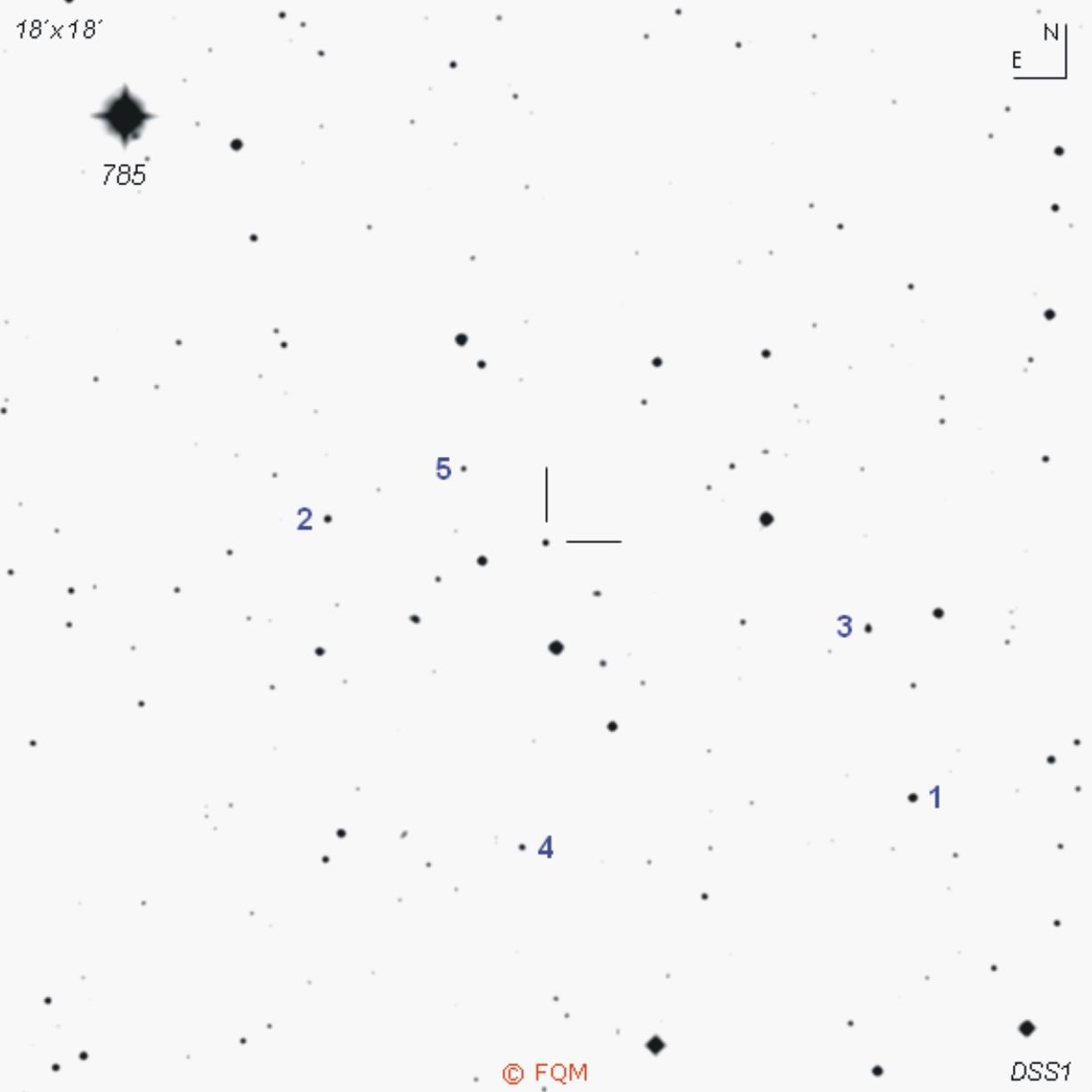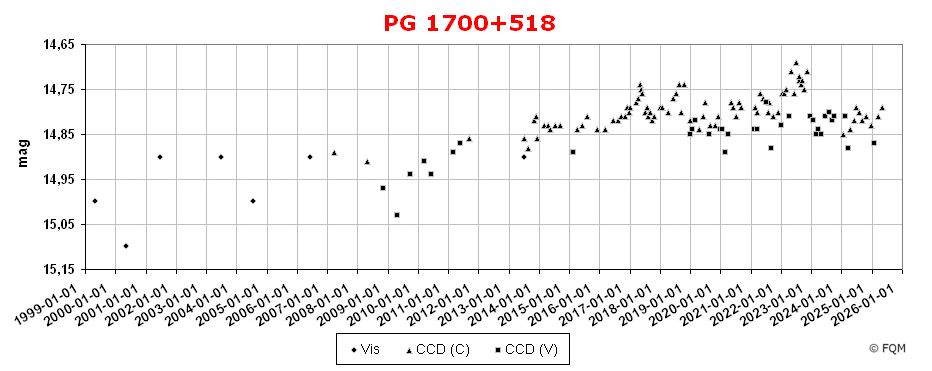
| Frankfurt Quasar Monitoring |
| PG 1700+518 |
| Cross-Identifications | SBS 1700+518, PG 1700+51, IRAS 17002+5153 2MASS J17012482+5149204, QSO B1700+518 1700+518, 2MASSi J1701248+514920 |
| Equat. coordinates | RA 17 01 25.0 DE +51 49 20 (J2000) |
| Constellation | Draco |
| Type | QSO |
| Redshift | z=0.292 |
| Distance (2) (3) |
1124 Mpc |
| Total mag range (mv) (4) (5) | 14.7 - 15.3 |
| Catalog Magnitude (1) | 15.12 |
| Absolute Magnitude (1) | -25.8 MB |
| Light Travel-Time (2) | 3.226 × 109 yrs |

Comparison stars
| star | B | V |
| 1 | 14.231 (0.068) |
13.655 (0.006) |
| 2 | 14.847 (0.034) |
14.261 (0.025) |
| 3 | 15.139 (0.057) | 14.612 (0.023) |
| 4 | 15.987 (0.058) | 15.163 (0.017) |
| 5 |
16.902 (0.171) | 15.946 (0.024) |



| PG
1700+518 is a radio-quiet quasar in southern Draco, some 4° west of
Draco´s head and close to the constellation Hercules. The designation PG
1700+518 refers to Palomar-Green Bright Quasar
Survey (PG), where this object was discovered between 1976 and 1982 as
a
blue stellar object of magnitude B=15.43. Spectroscopic
investigations revealed a Seyfert
1-spectrum with broad absorption lines. Therefore, PG:1700+518
was classified as a quasar (BAL
quasar).
As a blue stellar object, this quasar was also observed by both the
Second
Byurakan Survey (SBS) and the International Ultraviolet Explorer in the
early 1980s. The most
remarkable property of quasar PG 1700+518 is its strong emission in the
infrared (IRAS, 2MASS). PG 1700+518
is considered as one of the
infrared-brightest, radio-quiet quasars in the sky. High resolution
images, taken by Hubble Space Telescope and ground based
adaptive optics, revealed a galaxy collision between the host galaxy of
PG 1700+518 and a highly disturbed neighbouring system, which most
likely triggers the quasar activity of PG 1700+518 (see image above). PG 1700+518 is a low amplitude variable object with a total range of only about 0.5 magnitudes in the optical. During Frankfurt Quasar Monitoring project, a variability of only about 0.2 magnitudes has been detected. This agrees well with the results from the Hamburg Quasar Monitoring programme. CCD observers, as well as visual observers, shall use the comparison stars given above. Visual observers need at least a 10-inch telescope or larger to glimpse this quasar as a faint stellar object at a distance of about 3×109 light-years. Even with large instruments the quasar remains stellar. Locating quasar PG:1700+518 is quite easy: Just take the two brightest stars in the head of Draco, Gamma Draconis and Beta Draconis. Now, draw a line from Gamma to Beta. Move the same distance to the west and you are nearly there. A 7.85-mag field star, 10 arcmin NE of the quasar, leads directly to PG 1700+518 (see the bright star in the upper left corner of the finding chart above). ____________
Two bright and interesting deep sky showpieces are worth visiting. The first is M92, a bright globular cluster about 9° to the SSE. M92 is some 30 000 light-years distant and can be resolved using an 8-inch telescope or larger. Another globular cluster, NGC 6229, can be found 4.8° to the SSW. NGC 6229 is considered to be about 100:000 light-years away. The brightest stars in NGC 6229 are of mag 15.5, so observers need at least 12- to 14-inch of aperture to resolve some few very faint stars of NGC 6229. Finally, observers may like to turn to quasar PG 1718+481, a bright 14-mag object at the remarkable distance of nearly 8×109 light-years (!), only 4.7° SE. |
| Bicay, M.D., Stepanian, J.A., et al. 2000, A&AS, 147, 169; Accurate optical positions for 2978 objects from the Second Byurakan Survey (SBS) with the Digitized Sky Survey. Boroson, T.A., Green, R.F. 1992, ApJS, 80, 109; The Emission-Line Properties of Low-Redshift Quasi-Stellar Objects. Chavushyan, V.O., Stepanian, J.A., et al. 1995, AstL, 21, 804; CCD Photometry of QSO's from the Second Byurakan Survey. Giveon, U., Maoz, D., et al. 1999, MNRAS, 306, 637G; Long-term Optical Variability Properties of the Palomar-Green Quasars. Hansen, T. 1991, Deep Sky Magazine 34, 32; The "Deepest" Deep Sky Objects. Hutchings, J.B., Crampton, D., Campbell, B. 1984, ApJ, 280, 41; Optical Imaging of 78 Quasars and Host Galaxies. Hutchings, J.B., Neff, S.G. 1992, AJ, 104, 1; Optical Imaging of QSOs with 0.5 arcsec Resolution. Hutchings, J.B., Neff, S.G., et al. 1992, PASP, 104, 62; The Structure of the BAL QSO 1700+518. Karge, S.; Helle Quasare für 8- bis 10-Zoll Teleskope. Ein Beobachtungsführer zur visuellen Beobachtung von Quasaren und BL Lacertae Objekten; Frankfurt 2005. Markarian, B.E., Lipovetski, V.A., et al. 1983, Afz, 19, 29M; Second Byurakan Spectral Sky Survey. I - Quasistellar and Seyfert Objects. Márquez, I., Petitjean, P., et al. 2001, A&A, 371,97; Adaptive Optics Imaging of Low and Intermediate Redshift Quasars. Pettini, M., Boksenberg, A. 1985, ApJ, 294, 73; PG 1700+518 - A Low-Redshift, Broad Absorption Line QSO. Richards, G.T., Yanny, B., et al. 1997, PASP, 109, 39R; Quasar Photometry with the SDSS Monitor Telescope. Schmidt, G.D., Hines, D.C. 1999, ApJ, 512, 125; The Polarization of Broad Absorption Line QSOs. Schmidt, M., Green, R. 1983, ApJ, 269, 352; Quasar Evolution Derived from the Palomar Bright Quasar Survey and Other Complete Quasar Survey. Steinicke, W.; Katalog heller Quasare und BL Lacertae Objekte; Umkirch 1998. Véron-Cetty, M.-P., Véron, P. 2001, A&A 374, 92; A Catalogue of Quasars and Active Nuclei: 10th edition. Véron-Cetty, M.-P., Véron, P. 2003, A&A 412, 399; A Catalogue of Quasars and Active Nuclei: 11th edition. Véron-Cetty, M.-P., Véron, P. 2006, A&A 455, 776; A Catalogue of Quasars and Active Nuclei: 12th edition. Véron-Cetty, M.-P., Véron, P. 2010, A&A 518, 10; A Catalogue of Quasars and Active Nuclei: 13th edition. |
| Links: Hamburg Quasar Monitoring APASS |
| home |